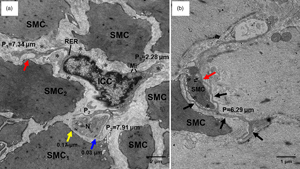No CrossRef data available.
Article contents
Ultrastructure and Morphometric Analysis of Interstitial Cells of Cajal in the Gastric Wall of the Bullfrog (Rana catesbeiana)
Published online by Cambridge University Press: 06 January 2022
Abstract

Interstitial cells of Cajal (ICC) play a vital role in the gastrointestinal motility. However, information on ICC in lower vertebrates is rare. Here, ICC and ICC-like features of the gastric wall in the bullfrog (Rana catesbeiana) were observed by light microscopy and transmission electron microscopy. The lengths and distances of the ICC/ICC-like features were measured by morphometric analysis. The gastric wall contained mucosa, submucosa, tunica muscularis, and serosa. The gastric glands contained mucous cells and oxynticopeptic cells. The ICC with 1–3 processes were located among smooth muscle cells (SMC) of the tunica muscularis. Moreover, the ICC-like features were observed among oxynticopeptic cells of the mucosa. The processes of ICC established direct contacts with SMC. Also, the gap junctions were observed between the processes of ICC and nerve fiber bundles in the tunica muscularis. The multivesicular bodies, including shedding exosomes, were frequently observed between ICC and SMC. In addition, ICC-like features and their processes were observed in close proximity to oxynticopeptic cells and blood vessels. Our findings illustrated that ICC are present in the gastric tunica muscularis, and ICC-like features were in the mucosal lamina propria of the gastric wall of R. catesbeiana. These histological evidences supported the notion that ICC are implicated in gastric motility.
- Type
- Micrographia
- Information
- Copyright
- Copyright © The Author(s), 2022. Published by Cambridge University Press on behalf of the Microscopy Society of America





